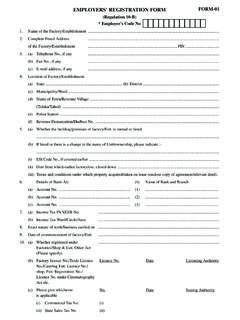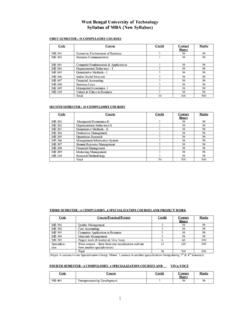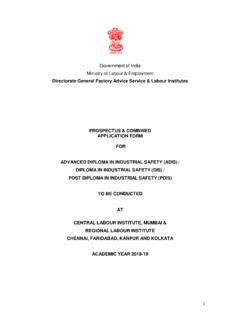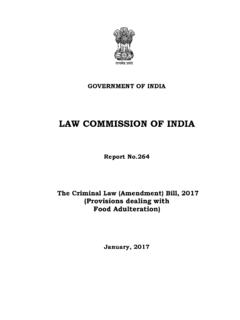Transcription of S T A N D A R D N O T E ON EMPLOYEES’ STATE …
1 1 S T A N D A R D N O T E ON EMPLOYEES STATE INSURANCE SCHEME (As on ) 1. The Employees STATE Insurance Act, 1948 is a social security legislation that provides for medical care and cash benefit in the contingencies of sickness, maternity, disablement and death due to employment injury to workers. A statement indicating the broad details of various health insurance related benefits provided under the Act is at Annexure-I. COVERAGE The Act applies, in the first instance, to, non-seasonal factories employing 10 or more persons. The provisions of the Act are being extended area-wise by stages. The Act contains an enabling provision under which the "appropriate government" is empowered to extend the provisions of the Act to other classes of establishments - industrial, commercial, agricultural or other-wise. under these provisions most of the STATE Govts.
2 Have extended the provisions of the Act to new classes of establishments namely: shops, hotels, restaurants, cinemas including preview theatres, road-motor transport undertakings and newspaper establishments employing 20 or more coverable employees. The Scheme has also been extended to Educational Institutions employing 20 or more persons in Rajasthan, Bihar, Pondicherry, Jammu & Kashmir, Uttarakhand, Chattisgarh, West Bengal, Jharkhand, Kerala, Uttar Pradesh, Andhra Pradesh, Assam, Punjab, Tamilnadu and to Private Medical Institutions in the STATE of West Bengal, Rajasthan, Bihar, Kerala, Himachal Pradesh, Uttarakhand, Andhra Pradesh, Punjab, Assam, UT Chandigarh, Jharkhand and Orissa. As of now, employees of factories/establishments mentioned above in the implemented areas and drawing wages (excluding overtime) not exceeding , 000/- per month are covered under the Act.
3 ADMINISTRATION 3. The Hqrs. of the ESI Corporation is located at Delhi and has 58 field offices such as 23 Regional Office, 26 Sub-Regional Office and 4 Divisional Office and 2 Camp Office and 3 Liaison Office throughout the county. Besides, there are 610 Branch Offices and 187 Pay Offices for administration of cash benefits to Insured Persons. For inspection and coverage of new factories/Establishment, 360 Inspection Offices have also been set up across the County. 2 FINANCE: 4. The ESI Scheme is financed mainly by contributions from employers and employees. The rate of contribution by employer is of the wages payable to employees. The employees contribution is at the rate of of the wages payable to an employee. The STATE Government s share of expenditure on the provision of Medical Care is to the extent of The maximum sharable amount is subject to the ceiling prescribed by the Corporation from time to time.
4 An expenditure beyond the prescribed ceiling is solely borne by the STATE Govts. ABSOLVING OF LIABILITY under OTHER ENACTMENTS 5. Employers coming under the purview of ESI Act, 1948, are absolved of their liability under the Workmen s Compensation Act, 1923 and the Maternity Benefit Act, 1961, as these social security provisions become the responsibility of the ESI Scheme. PROVISION FOR EXEMPTION FROM THE OPERATION FO THE ACT 6. An appropriate government may grant or review exemption under Section 87 of the Act in respect of a Factory/Establishment or class of factories or establishments in any specified area. Provided that an application for renewal shall be made three months before the date of expiry of the exemption period and a decision on the same shall be taken by the appropriate Government within two months of receipt of such application and under section 88 to any person or class of persons employed in any factory or establishment to which the Act applies, from the operation of the Act for a period not exceeding one year at a time to take effect only prospectively.
5 As per provisions of the Act no exemption shall be granted unless a reasonable opportunity is given to the Corporation to make any representation and the same is considered by the appropriate Govt. Exemption under Section 88 of the Act is granted to employees or class of employees who remain away from their Hqrs. for more than 7 months in a year and those who are posted in non-implemented areas. Exemption under Section 90 is granted to a factory/establishment belonging to a local authority such as a Municipality/Corporation, etc. if employees in any such factories/establishments are otherwise in receipt of benefits substantially similar or superior to the benefits provided under the Act. 3 POLICY OF THE CORPORATION IN GRANTING EXEMPTION under SECTION 87 AND 91 OF THE ACT 7.
6 The Corporation at its meeting held on 12th September, 1985 constituted a sub-Committee under the Chairmanship of Miss Meera Seth, Addl. Secretary, Ministry of Labour to examine the policy of the exemption. The Sub-Committee after careful consideration of all pros and cons of exemption had opined that any liberalization of exemption policy would not only be contrary to the concepts of social security but also against the objectives of the ESI Scheme and against the larger interest of the workers themselves. The Sub-Committee was, therefore, not in favour of granting exemption from the Act at all to any factory or establishment. (i) Whereas Section 87 permits grant of exemption for a period not exceeding one year at a time, no such time limit has been specified for exemptions granted under Section 88 and 90 which may be specified, and (ii) The conditions of superiority or similarity of benefits as stipulated under Section 90 may also be stipulated as one of the conditions for grant of exemption under Section 87.
7 The Recommendations of the Sub-Committee were accepted by the ESI Corporation at its meeting held on 20th February, 1986. EXTENSION OF ESI SCHEME TO NEW SECTORS OF EMPLOYMENT 8. The Committee on Perspective Planning (1972) of the ESI Corporation which had been appointed, inter-alia to work out a viable programme for phased extension of the Scheme, had formulated the following criteria for extension of the Scheme to a larger cross section of wage earners:- (a) Need for health insurance protection; (b) Feasibility of building upon expanding viable medical facilities; and (c) Amenability of the establishments to enforcement by the Corporation. Applying the above mentioned criteria, the Committee came to the conclusion that extension of the scheme should be accomplished in three phases, as given below:- (i) In the first phase, factories run with power and employing 10 to 19 workers; factories run without power employing 20 or more workers and shops, cinemas including preview theater, road motor transport undertakings and newspaper establishments, hotels and restaurants employing 20 or more workers are to be covered.
8 4(ii) The organized mines and plantations might be covered in the second phase. In the case of mines and plantation the recommendation of the Committee was to extend the Scheme only partially only the cash benefits might be provided since medical care was already available to the workers free of cost. (iii) The unorganized or semi-organised sectors about which accurate statistical data is not available would come later in the third phase. In pursuance of the above recommendations, extension of the scheme to the categories of establishments included in the first phase has already been carried out. 9. PROVISION OF SOCIAL SECURITY FOR WORKERS IN THE UNORGANISED SECTOR Out of the total work force of about 459 millions in India, Million workers are in the organized sector, ( million in public sector and million in private sector) and the rest are in the unorganized sector.
9 The ESI Act covers workers in the organized sector only. At present about million workers ( of organized sector) are covered under the Employees' STATE Insurance Act, which represents only about of the total work force in the country. The remaining workers in the organized sector to which the ESI Act does not apply remain outside the social security umbrella due to the following reasons:- (i) Employees of Central and STATE Govts. who are provided social protection under the rules of the respective Governments; (ii) Workers of factories/establishments employing less than 10 persons. (iii) Workers of factories/establishments situated in the non-implemented areas, where the ESI Scheme has not been implemented; (iv) Workers of seasonal factories/establishments; (v) Workers drawing wages exceeding ,000/- per month.
10 The workers engaged in agriculture and allied activities, household industry, building and construction, small factories/establishments, home workers, domestic servants, artisans, self-employed persons such as fishermen, hawkers, auto-rickshaw drivers etc. all constitute the informal or unorganized sector. The main characteristics of workers in the unorganized sector are acute incidence of under employment, the scattered nature of work places, high incidence of home-based or, low collective bargaining power and the absence of an employer-employee relationship. 5 The workers employed in the organized sector and working in the smaller factories and establishments can be brought under the ESI Scheme by gradually lowering the threshold limit for coverage under the ESI Act.















